Amid Mexico's Drug Violence, These Bike Riders Are Fighting to Take Back Their Streets


“Are you ready?” Joel Mancinas asks me. We hop on our bikes, leaving the quaint center of Icamole, a small town 35 miles northwest of Monterrey in the state of Nuevo León, speeding down the road as the cool, crisp air scrapes our cheeks under a blue spring sky.
The road is quiet at 7 a.m. We are the only cyclists in sight and pedal into the gravelly desert surrounding Icamole, barren mountains in the distance. Our bikes immediately bounce over the rocks, and I death-grip the handlebar. For Mancinas, 58, owner of a photography shop and an avid cyclist, this is a leisurely ride. For me, a journalist and novice on the bike, it is both a physical test and a search for a sense of freedom.
For nearly two decades, drug cartel violence has been part of daily life in many areas of northern Mexico. In Nuevo León, the situation calmed somewhat in the past few years, but a recent uptick in shootings have revived the precautions and mobility restrictions that citizens imposed on themselves in the early years of the war on drugs in the 2010s.

Mexico’s long war against drug cartels began in late 2006, when former president Felipe Calderón deployed 50,000 soldiers onto the nation’s streets, leading to a surge in violence and widespread human rights violations. With assistance from the United States, Calderón’s strategy focused on eliminating the drug lords. But according to critics, the removal of kingpins only led to a fragmentation of the cartels and an increase in violence.
The Mexican government’s strategy of using the military to crack down on cartels continues to fail today. The current president, Andrés Manuel López Obrador, has deployed even more army and national guard troops throughout the country. Nevertheless, homicides, shootouts, and disappearances are the norm in many parts.
Amid these fears, groups of cyclists in the region in Nuevo León have been slowly and steadily reclaiming public spaces by riding together. Strengthened and emboldened by a sense of community, they venture into areas that for safety reasons many residents would avoid themselves. In a place that can be hostile, these riders view cycling as a force, not a vulnerability. And as a journalist investigating human rights violations, I wanted to understand more. So I reached out to Mancinas, who founded one of the first cycling groups in the region.

As we advance, the slopes grow steeper and the sun beats stronger, turning the cold air into a chilly breeze. The rocks get bigger, and maneuvering the bike becomes more difficult as I dodge creosote bushes and ocotillo shrubs. Suddenly my front tire hits a mound of coarse gravel and stones. I hover out of the saddle and try to keep moving, but the pedals won’t cooperate. I brake and then get off the bike, frustrated, while Mancinas simply stops up ahead without looking back, as if he wants me to find my own way. I exhale like a horse.
Bikes have been part of life for Mancinas since he was a child riding his father’s 28-inch bicycle in his hometown in the state of Zacatecas, in north-central Mexico. His feet could barely reach the pedals, so he had to stand to keep going. When his siblings laughed at him, Mancinas pedaled harder.
He got more serious about riding in 2000, after turning 35 and noticing that he was short of breath when going up the stairs. He bought a bicycle that was more expensive than he could afford—4,000 pesos—hoping it would be enough motivation to start exercising. He didn’t know any routes in Monterrey other than the way to the track in the city center. Back then, Monterrey had less cycling infrastructure than it does today, and drivers were less willing to share the road. But Mancinas believed that the only way to change that was to take to the streets. “It’s not that society has to change for me to ride a bike; I have to ride a bike for society to change,” he says.
In 2010, as the Mexican government’s war against the drug cartels was ramping up, residents were observing an unofficial nighttime curfew. Mancinas and a few friends kept riding through Monterrey at night despite the risks of shootouts, gruesome homicides, and disappearances. As more people joined Mancinas, the nighttime bike ride officially became known as the Dangerous Tour. The group grew over the next eight years until as many as 300 riders joined each Thursday, revolutionizing the use of the streets in the state of Nuevo León, an important industrial hub.

“Many people ask if we called it the Dangerous Tour because it was dangerous to ride on the streets, but I tell them, ‘No, it was dangerous because we rode in the most dangerous places in the city,’” says Mancinas, referring to the threat of organized crime in those areas.
By 2018, thanks to social media, the movement behind Dangerous Tours had grown and spread to different communities in the state. As more people got involved, riders—especially those who lived far from the city—introduced separate outings back in their own municipalities. By the end of the year, what had begun as Dangerous Tours had broken into smaller groups that eventually gained more riders and popularity during the pandemic. Lourdes Balandrán is one of those people who decided to create a new group.
After her mother passed away in 2020, Balandrán joined some cycling groups in Juárez, some 15 miles outside Monterrey, and soon she was invited to organize and lead a group of female cyclists called Fridas en Bici. Many members dusted off their old or borrowed bikes, and others found cheap ones online. Balandrán motivated and guided them based on what she had learned on her own: Bring water, a helmet, and gloves. Wear clothes without seams. If it’s night, bring lights. Always stay riding together.

Every Thursday, the riders of Fridas en Bici take over the streets of Juárez, but they are no longer just women. Balandrán decided to open the group to men and children to encourage family togetherness and a sense of protection. Gender-based violence has not only been on the rise across Mexico, but also become increasingly frequent in public spaces. Ricardo Solorio, Balandrán’s husband, often helps coordinate the group with walkie-talkies, making sure they stay together, and picking up teammates left behind. When they hear about violent events, they change their route.
“They have never messed with us, but here we see [cartel members],” he says. “When they say the thing está caliente and they start finding dead people, we don’t go into those trails.”
I join Balandrán and others on a sweltering Thursday evening for a night ride organized by the Fridas. Around 9 p.m., a dozen cyclists on all kinds of different bikes arrive at a small adobe store for a water break in the community of Santa Ana, in the old part of Juárez. We’ve been riding for 45 minutes along the narrow dirt road illuminated by a full moon. The riders—friends, couples, families, three children, and two newbies—gather outside, sipping their drinks and chatting before getting back on our bikes.
We make our way down the dark road lined with oak trees before crossing a stream of the Santa Ana River, which has little water due to the region’s ongoing drought, and pedaling up a small slope in the glow of fireflies. For the next few hours of the night, with no cars in sight, the streets belong to us. The silence could be peaceful if not for the hovering threat of cartel violence.
Even though the cartels rarely target cyclists, the threat is always there, like the buzzing of a mosquito that you may not notice until it is right at your ear. Riders also contend with the risk of traffic violence. Josué Olvera commutes by bike daily in Juárez; there’s no bike lane, so he dodges cars, buses, and trucks to get to the paper cup factory where he works. Although the 21-year-old has been biking for five years, he joined Fridas en Bici more recently to ride in company and explore new routes.
Mancinas believes that the additional groups that emerged out of the Dangerous Tours created a sense of strength in numbers, allowing cyclists to reclaim public spaces. As they rode in large groups, they took back their place on the roads. They had been invisible, Mancinas says. “[It was like] a social movement. People started to see us. It’s not the same to ride alone [as it is] in a group.”
Mancinas remembers the time when, during one of the Dangerous Tour’s night rides near Santiago, a charming town in the Sierra Madre Oriental, members of organized crime stopped them. When they asked who the leader of the group was, Mancinas stepped forward. They asked where they were going, and then let them pass without any problem.

in a group," Mancinas said of The Dangerous Tour.' expand='' crop='8x10'][/image]
Some bike riders remain untroubled by the threat of violence, even when they’re out alone. Fernando Salazar, a longtime cyclist and gravel cycling promoter, rides solo, mainly in the desert. On occasion Salazar has encountered vehicles belonging to organized crime, in which the occupants openly carry their weapons. Despite this, he continues his journey without having to stop. “They ignore me,” Salazar says. “But I wouldn’t go into areas that I know are problematic.”
En las brechas, se esconden los malitos (“In the gap trails, the bad guys hide”) is kind of a folk tale that is closer to reality than fiction. “Gap trails” refers to roads that traverse areas with no internet, making it harder for authorities to track criminal activity. As Salazar points out, the golden rule is not to be in those places, especially at night. But he also says that residents have learned to coexist with risk and violence: “You learn to live with all of that.”
These days, not many people join Mancinas for the 100 or so miles he rides on weekends. When he wants to get away from the noise and smog of the city, he seeks the mountains or the desert. “The countryside beckons,” he says with a smile. And despite a recent uptick in violence in Nuevo León, he continues to explore new routes, particularly in the rural areas of the state, and also shares on social media his reflections and experiences along the way.
Back in the desert outside Icamole, Mancinas seems to glide on the rugged terrain while I struggle to keep up, especially when we encounter soft sand patches. “How do I go through these sandbanks with my bike?” I yell. With a slight smile, he turns around and explains: “Anticipate the terrain. Shift right before descending, hover out of the saddle, and push down on the pedals quickly and forcefully. Don’t stop.”

I push, I groan, and I emerge victoriously from the sand patch, laughing toward the sky. With the wind at my back, I begin to understand the feeling of freedom that cyclists enjoy. Mancinas suggests we stop for breakfast. As we sit on some stones with the mountains in front of us, he lights a portable mini gas stove and starts frying eggs and ham. The desert with its hidden roads begins to look like what it is—a desert—and not a place occupied by others with hidden threats. Mancinas grabs a flour tortilla and deposits the egg in it. As he takes a bite, he leans his back against the tall stone, letting out a breath. This time, the silence is peaceful.
You Might Also Like

